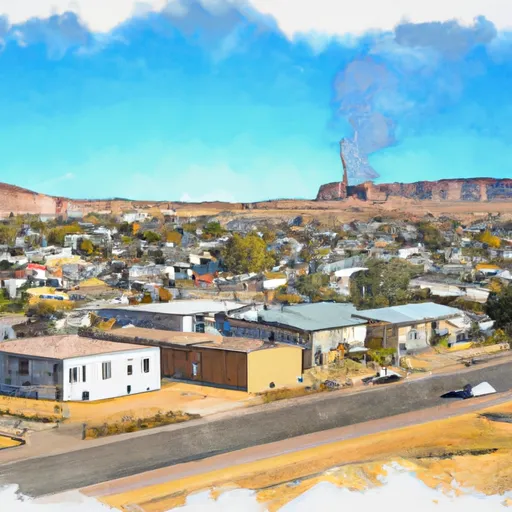-
 Snoflo Premium
Snoflo Premium
Get unlimited access to all our content
With no Ad interruptions! - Start Your Free Trial Login with existing account
Littlefield
Eden Index
Climate
8.7
•
Recreation
5.0
•
Community
1.5
•
Safeguard
5.6/10

Littlefield, Arizona is a small town located in Mohave County, in the northwestern part of the state. The area is known for its warm and arid climate, typical of the desert Southwest. Summers in Littlefield are hot, with temperatures often exceeding 100 degrees Fahrenheit, while winters are mild, with temperatures ranging from the mid-40s to the low 60s. The region receives very little rainfall, averaging around 7 inches per year, contributing to the arid conditions.
Hydrologically, Littlefield is situated near the Virgin River, a tributary of the Colorado River. The river and its associated aquifers provide the main source of water for the town and its surrounding areas.
Outdoor recreation opportunities in Littlefield and its vicinity are abundant. The town is surrounded by beautiful desert landscapes, offering opportunities for hiking, off-roading, and exploring the scenic desert flora and fauna. The Virgin River provides opportunities for fishing and boating, while nearby areas have camping grounds and RV parks for those who wish to enjoy the outdoors for an extended period. Additionally, Littlefield is close to the Grand Canyon, making it a convenient base for visiting one of the Seven Natural Wonders of the World.
What is the Eden Index?
The Snoflo Eden Index serves as a comprehensive rating system for regions, evaluating their desirability through a holistic assessment of climate health, outdoor recreation opportunities, and natural disaster risk, acknowledging the profound impact of these factors on livability and well-being.
Climate Health Indicator (CHI): 8.7
Littlefield receives approximately
191mm of rain per year,
with humidity levels near 52%
and air temperatures averaging around
19°C.
Littlefield has a plant hardyness factor of
8, meaning
plants and agriculture in this region tend to thrive here all year round.
By considering the ideal temperature range, reliable water supplies, clean air, and stable seasonal rain or snowpacks, the Climate Health Indicator (CHI) underscores the significance of a healthy climate as the foundation for quality living.
A healthy climate is paramount for ensuring a high quality of life and livability in a region, fostering both physical well-being and environmental harmony. This can be characterized by ideal temperatures, reliable access to water supplies, clean air, and consistent seasonal rain or snowpacks.
Weather Forecast
Streamflow Conditions
Lower Colorado-Lake Mead
Area Rivers
Lower Colorado-Lake Mead
Snowpack Depths
Lower Colorado-Lake Mead
Reservoir Storage Capacity
Lower Colorado-Lake Mead
Groundwater Levels
Recreational Opportunity Index (ROI): 5.0
The Recreational Opportunity Index (ROI) recognizes the value of outdoor recreational options, such as parks, hiking trails, camping sites, and fishing spots, while acknowledging that climate plays a pivotal role in ensuring the comfort and consistency of these experiences.
Access to outdoor recreational opportunities, encompassing activities such as parks, hiking, camping, and fishing, is crucial for overall well-being, and the climate plays a pivotal role in enabling and enhancing these experiences, ensuring that individuals can engage in nature-based activities comfortably and consistently.
Camping Areas
| Campground | Campsites | Reservations | Toilets | Showers | Elevation |
|---|---|---|---|---|---|
| Gunlock State Park | None | 3,609 ft | |||
| Virgin River | 75 | 2,256 ft |
Nearby Fishing
Nearby Ski Areas
Catastrophe Safeguard Index (CSI):
The Catastrophe Safeguard Index (CSI) recognizes that natural disaster risk, encompassing floods, fires, hurricanes, and tornadoes, can drastically affect safety and the overall appeal of an area.
The level of natural disaster risk in a region significantly affects safety and the overall livability, with climate change amplifying these risks by potentially increasing the frequency and intensity of events like floods, fires, hurricanes, and tornadoes, thereby posing substantial challenges to community resilience and well-being.
Community Resilience Indicator (CRI): 1.5
The Community Resilience Indicator (CRI) recognizes that education, healthcare, and socioeconomics are crucial to the well-being of a region. The CRI acknowledges the profound impact of these elements on residents' overall quality of life. By evaluating educational resources, healthcare accessibility, and economic inclusivity, the index captures the essential aspects that contribute to a thriving community, fostering resident satisfaction, equity, and social cohesion.

